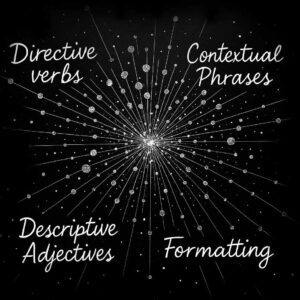Structured prompting is a way of giving instructions to AI, so they can do tasks more accurately and dependably. This method is about creating clear and well-organized instructions that help the AI know exactly what to do, aiming to get consistent results. This guide will explain the basics of how to do this, including how to set clear goals, give step-by-step directions, use your own knowledge effectively, set rules for the AI, make the instructions personal, and how giving examples can help the AI learn better.
Role and Goal
The foundation of a structured prompt lies in clearly defining the role of the AI and the goal of the task. This dual focus helps in narrowing down the range of possible responses the AI might generate, aligning them more closely with the user’s expectations. For instance, assigning the AI the role of a tutor in a learning scenario can leverage its pre-trained knowledge to simulate an educational conversation. The goal should be specific, such as guiding a student through a complex problem-solving process, thereby setting a clear direction for the interaction.
Step-by-Step Instructions
One of the most effective strategies in structured prompting is providing the AI with step-by-step instructions. These instructions should be as clear and straightforward as possible, avoiding ambiguity and complexity that might confuse both human readers and the AI. A well-organized prompt enhances the likelihood of obtaining useful output, directing the AI through the task in a logical and orderly manner. This method is particularly beneficial when dealing with complex tasks or multi-step problems, ensuring that each part of the process is addressed in turn.
Expertise
Incorporating your own expertise into the prompt is crucial. This involves not just telling the AI what to do, but also guiding it on how to approach the task based on your understanding and perspective. For example, if the task involves a pedagogical goal, such as encouraging students to identify potential failure points in a project, your prompt should reflect a strategy that emphasizes inquiry over direct instruction, nudging students towards self-reflection and discovery.
Constraints
Setting constraints within your prompt can significantly influence the AI’s behavior and the quality of its output. Constraints can range from specifying the role dynamics (e.g., the AI should wait for the user’s input before proceeding) to limiting the scope of responses (e.g., keeping answers concise). These guidelines help in making the interaction more predictable and manageable, especially in complex scenarios where the AI might otherwise stray off course.
Personalization
Personalization plays a key role in structured prompting. By designing prompts that encourage the AI to solicit information from the user, you can create a more tailored and relevant interaction. This approach can be particularly effective in scenarios where the AI acts as a guide, asking probing questions that help users clarify their thoughts and objectives. Personalization ensures that the AI’s responses are more directly aligned with the user’s specific needs and context.
Examples and Few-shot Learning
Incorporating examples into your prompt, a technique known as few-shot learning, can significantly enhance the AI’s ability to grasp and respond to your request. By providing a small number of examples that illustrate the desired output or reasoning process, you give the AI concrete references to model its responses after. This method can be especially useful when you’re aiming for a specific style or format in the AI’s output.
Asking for Specific Output
Finally, don’t hesitate to specify the type of output you’re looking for, whether it’s an explanation, a chart, a document, or any other form of content. The versatility of AI models means that they can generate a wide range of outputs, so being explicit about your expectations can help steer the AI in the right direction.
The Structure Prompt in a Nutshell
- Role and Goal:
- Define the AI’s role and the task’s goal to narrow down potential responses and align them with user expectations. For example, the AI could act as a tutor, focusing on educational goals.
- Step-by-Step Instructions:
- Provide clear, straightforward instructions to guide the AI through the task, enhancing the chance of getting useful output, especially in complex or multi-step tasks.
- Expertise:
- Incorporate your knowledge into the prompt to guide the AI on how to approach the task, emphasizing strategies that reflect your understanding of the task at hand.
- Constraints:
- Set rules within the prompt to influence the AI’s behavior and output quality, such as waiting for user input before proceeding or limiting response length.
- Personalization:
- Design prompts that encourage the AI to ask questions, making the interaction more tailored to the user’s specific needs and context.
- Examples and Few-shot Learning:
- Use a few examples to help the AI understand the desired output or reasoning process, improving its ability to respond appropriately.
- Asking for Specific Output:
- Be clear about the type of output you expect, such as an explanation, chart, or document, to guide the AI’s response in the desired direction.
Structured Prompt Example 1: Writing a Children’s Story
I need your assistance in crafting a unique children's story that captures the whimsical and rhythmic essence of Dr. Seuss's writing style. Here's how we'll accomplish this: Role and Goal: You are now a creative writer specializing in children's literature, specifically in the style of Dr. Seuss. Your goal is to create a story that engages young readers with its playful language, rhymes, and imaginative characters. Step-by-Step Instructions: Step 1: Begin by introducing a main character with a unique, Seuss-like name and a quirky personality trait. Step 2: Create a setting that is vibrant and fantastical, full of colorful landscapes and whimsical architecture. Step 3: Develop a simple, engaging plot that involves the main character overcoming a challenge or learning a valuable lesson. Incorporate playful conflicts and resolutions. Step 4: Write the story using rhyming couplets or alternating rhyme schemes, mimicking Dr. Seuss's signature style. Focus on a playful use of language, making up words if necessary to maintain the rhyme. Step 5: Conclude the story with a memorable moral or message that leaves a positive impact on the reader. Expertise: Keep in mind Dr. Seuss's approach to storytelling, which blends humor with heartwarming lessons. Your story should not only entertain but also impart a meaningful message to its young audience. Constraints: Your story should be suitable for children aged 4-8. Keep the narrative under 500 words to ensure it's easily digestible for young readers. Use simple, direct language with a focus on rhyming and rhythm. Personalization: While following the guidelines, feel free to infuse the story with originality. Dr. Seuss was known for his unique characters and settings, so let your imagination run wild! Specific Output Request: Please present the story in prose format, ready to be illustrated and read aloud. The final output should be a coherent, engaging narrative that follows the structure outlined above. By adhering to these instructions, we can create a story that pays homage to the beloved style of Dr. Seuss, capturing the hearts and imaginations of young readers."
This prompt clearly outlines the role and goal for the AI, setting the expectation right from the start. The step-by-step instructions break down the task into manageable components, guiding the AI through the process of creating a story in a specific style. Expertise is invoked by highlighting the importance of mirroring Dr. Seuss’s unique approach to storytelling. Constraints ensure the story remains appropriate for the target age group and within a suitable length, while the call for personalization encourages creativity within these bounds. Finally, by asking for a specific output—a prose story ready for illustrations and reading aloud—the prompt sets a clear target for the AI to achieve.
Structured Prompt Example 2: Writing a Cover Letter
I'm seeking your assistance to create a compelling and professional cover letter for a job application. The goal is to highlight the applicant's skills, experiences, and passion in a manner that aligns with the job they're applying for. Here’s how we can achieve this together: Role and Goal: Assume the role of a career advisor with expertise in resume and cover letter writing. Your goal is to craft a cover letter that effectively markets the job applicant to their potential employer, showcasing why they are the ideal candidate for the position. Step-by-Step Instructions: Step 1: Start with a brief introduction of the applicant, mentioning the job they are applying for and how they discovered the opportunity. Step 2: In the next paragraph, detail the applicant's relevant skills and experiences. Connect these directly to the requirements listed in the job description, using specific examples where possible. Step 3: Highlight one or two key achievements of the applicant that are particularly relevant to the job. Use quantifiable results to demonstrate impact. Step 4: Explain the applicant's motivation for applying to the company and how their personal values align with the company's mission or culture. Step 5: Conclude the cover letter by expressing enthusiasm for the opportunity to discuss their candidacy further, including a polite call to action inviting the employer to contact the applicant for an interview. Expertise: Keep the tone professional yet personable. The cover letter should reflect the applicant's personality and enthusiasm for the position, without being overly casual or familiar. Constraints: Ensure the cover letter does not exceed one page in length, maintaining brevity and relevance throughout. Use clear, concise language and avoid industry jargon that the hiring manager may not understand. Tailor the cover letter to a fictional job in the field of marketing, focusing on creativity, teamwork, and digital skills. Personalization: Incorporate details that make the cover letter specific to the job and company, such as mentioning a recent company achievement or initiative that inspired the applicant. This shows the applicant has done their research and is genuinely interested in the role. Specific Output Request: Provide the cover letter in a format that is ready to be sent to a potential employer. This includes a professional greeting, well-organized body paragraphs, and a formal closing with the applicant's contact information. Following these detailed instructions, we aim to produce a cover letter that not only highlights the applicant's qualifications and enthusiasm but also demonstrates their fit and interest in the company and the specific role they are applying for."
This prompt is structured to guide the AI through the process of writing a professional and tailored cover letter. It starts by establishing the role of the AI as a career advisor and outlines the specific goal of the task. The step-by-step instructions ensure that all critical components of a cover letter are addressed, from introduction to conclusion. Invoking expertise helps to maintain an appropriate tone throughout the letter, while constraints ensure that the content remains focused and concise. Personalization is emphasized to make the letter stand out to employers, demonstrating the applicant’s genuine interest in the position. Finally, by requesting a specific output format, the prompt ensures that the cover letter is ready for immediate use in job applications.
To incorporate a pasted job description within the structured prompt without causing confusion, it’s important to place it at a point in the prompt where it naturally fits into the flow of instructions and to clearly indicate its purpose.
We have a handy tool here on Word.Studio that can help you write a cover letter with AI (no prompt is needed).
Experiment with Structured Prompts
Structured prompting is more than just a way to communicate with AI; it’s a strategic approach that enhances the efficiency and effectiveness of AI interactions. By carefully crafting your prompts to include clear roles and goals, step-by-step instructions, expert insight, appropriate constraints, personalization, examples, and specific output requests, you can guide the AI to deliver results that meet your needs more reliably. Experimentation and adjustment are key, as no prompt will be perfect from the outset, but with practice and refinement, you can achieve consistently better outcomes from your AI collaborations.









